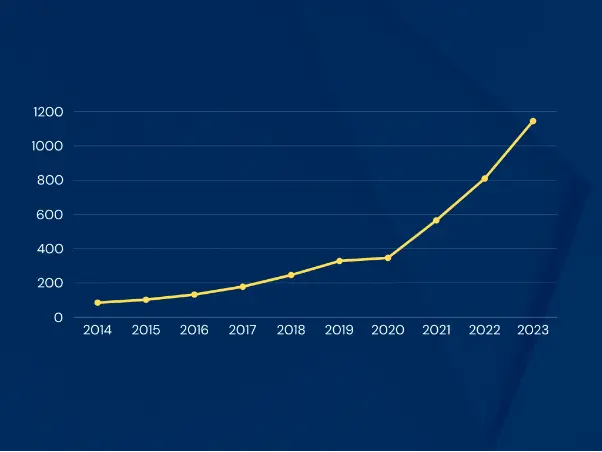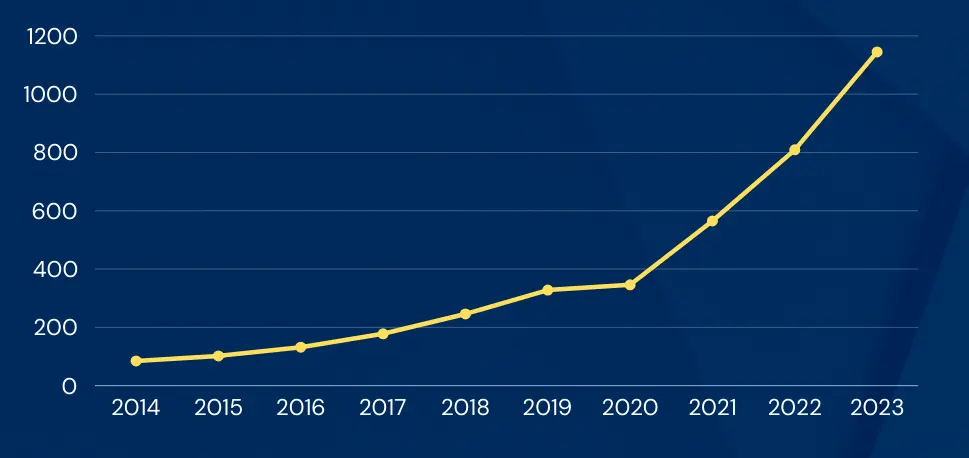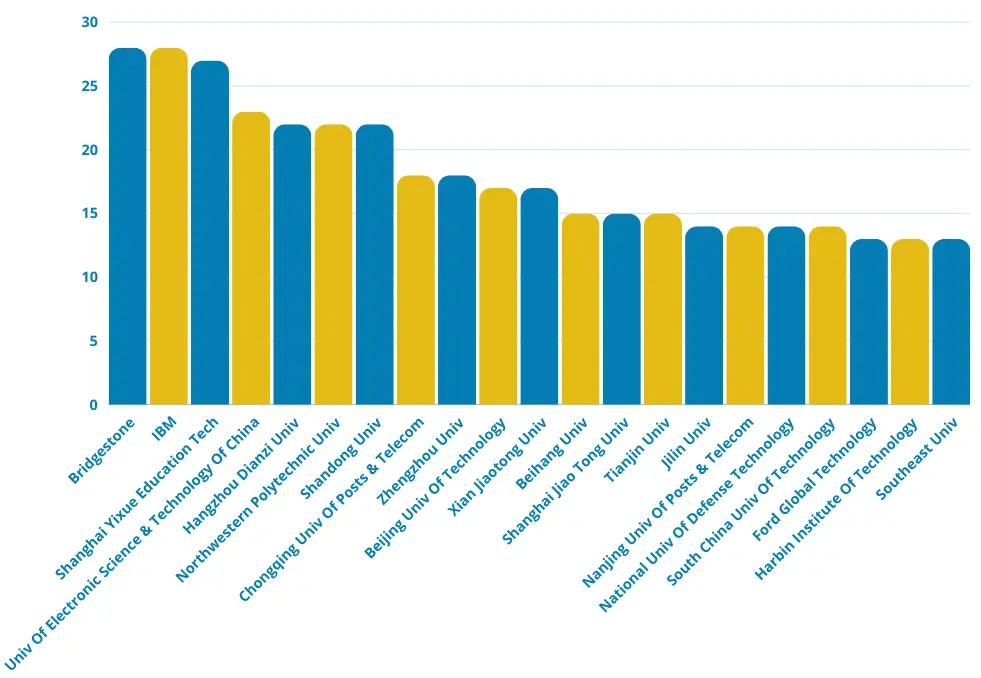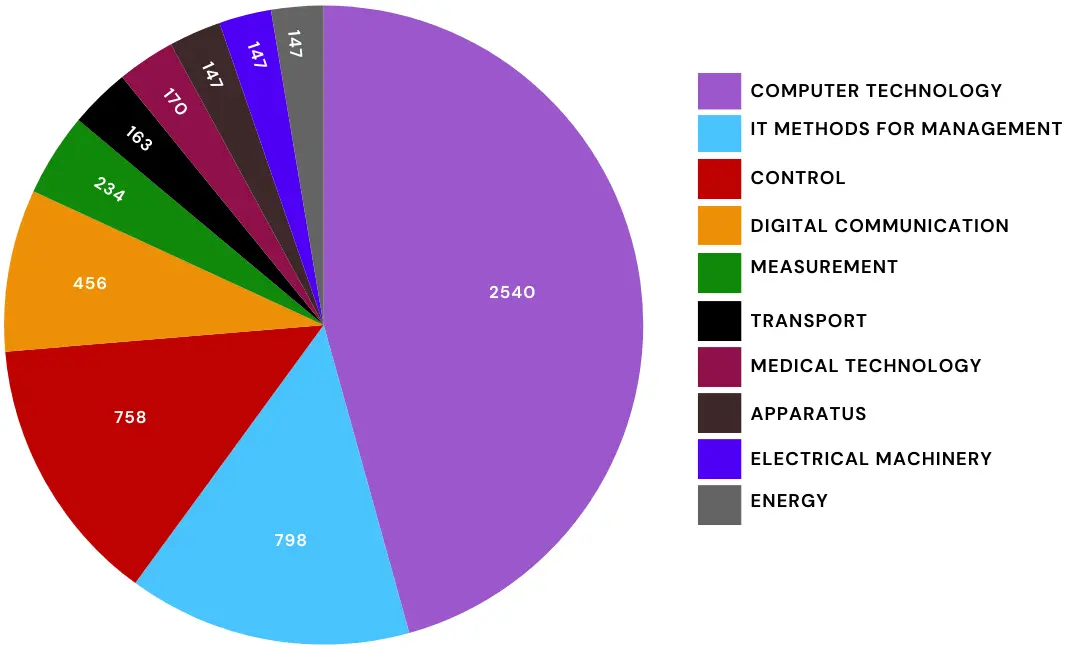
Precision learning, characterized by its personalized and adaptive approach to educational delivery, has emerged as a significant opportunity in modern education. Concurrently, the development of advanced security technologies in education has improved integrity and confidentiality of online learning platforms, fostering significant growth and evolution within this industry.
This analysis of the patented technologies in precision learning over the last 10 years [2014-02-21 to 2024-02-21] investigates the patent landscape, examining innovations driving the sector forward. By reviewing patent filings in the last one decade, our aim is to provide industry professionals, researchers, and potential investors with valuable insights into the trajectory of technological advancement in precision learning.
Our objective extends beyond mere dissemination of information. We look forward to fostering collaborative endeavours and facilitate strategic decision-making processes across the industry possibly helping companies make patent purchase decisions. Through identification of growth prospects, identification of untapped avenues, and delineation of future research and development trajectories, our aim is to equip stakeholders such as investors and technology corporations with the insights necessary to understand the landscape of precision learning with confidence and foresight.
This analysis offers a comprehensive examination of the patent landscape concerning Precision Learning and Precision Education. Initially, a corpus of approximately 10,281 distinct patent families, totalling 7,135 patents, underwent thorough scrutiny. Through triaging and relevance assessment, 4,178 unique patent families relevant to precision learning were identified and evaluated for preparing this analysis. Originating from diverse jurisdictions worldwide, these patents encapsulate a decade of advancements leading up to February 2024. This provides a panoramic insight into the technological progression and unexplored territories within this area, offering valuable opportunities for enterprises interested in acquiring or developing patents in this burgeoning sector.
The graphical representation below depicts the quantity of unique patent families published annually concerning precision learning and education. Spanning from 2014 to Feb 2024, this data underscores a discernible pattern in patent filing activity across the years.

Over the last ten years, this technology space has experienced a discernible uptick in patent activity, reflecting the industry’s dynamic progression and ingenuity. The sector has matured into a flourishing environment, culminating in 1145 patents published solely in 2023. This substantial expansion underscores the escalating significance and allocation of resources towards precision learning and education technologies, highlighting a clear trend towards increased innovation and investment in this domain.
Throughout this period, there has been a notable escalation in patent applications, with the count escalating from 85 in 2014 to 1145 in 2023.
With the advancement of AI, the frequency of references to deep learning within patent filings demonstrated a notable annual growth rate averaging 175% over the period spanning 2013 to 2016. The notable rise in mentions of deep learning within patent filings marks a significant turning point, catalysing a subsequent surge in precision learning patent submissions.
In 2019, a significant milestone was reached with 300+ filings, signalling the onset of a substantial increase. This trend persisted through 2023, with filings ascending to 1145. These figures underscore the interest and investment in innovation in the sector, indicative of a vibrant landscape of intellectual property development.
This surge in innovation interest can be attributed in part to the training industry, which boasted an estimated worth of approximately $370 billion in 2019. Specifically, the leadership segment alone represented a $50 billion industry.
This data highlights the growing significance of innovation in this industry, driven by substantial market values and a keen focus on intellectual property development.
The surge observed in patent filings, peaking at 1145 in 2023, proves the important role of precision learning technology within the broader landscape of educational technology. This trend indicates a critical and swiftly evolving domain necessitating continuous adaptation to meet emerging challenges and match the dynamic contours of digital learning.
There is a competitive and inventive milieu characterized by the combined innovation of the established industry leaders and up-and-coming contenders and startups. Check out this article about the top players in the precision learning and education innovation industry.
Bridgestone Corp, a prominent entity within the digital learning technology sector, stands at the forefront with a portfolio comprising more than 28 unique patent families. The company’s leadership in patent filings shows a substantial investment in research and development (R&D), aimed at fostering innovation and potentially establishing industry benchmarks in precision learning and education.
In addition to Bridgestone, notable entities such as IBM Corp, Shanghai Yixue Education Tech Co. LTD., University of Electronic Science & Technology of China, and Hangzhou Dianzi University have also made significant contributions through patent filings.
Entries like Nanjing UNIV of Posts & Telecom, indicating a global recognition of the importance of precision learning technology. These entries, along with others like FORD Global Technology LLC and Harbin Institute of technology, suggest that innovation in precision education is not confined to traditional education markets or players, but is a field of interest across different sectors and regions of the globe.

The emergence of the COVID-19 pandemic on a global scale has significantly impacted the education sector, prompting a surge in demand for remote learning solutions. The need to mitigate the spread of the virus has led to the implementation of restrictions on physical visits to educational institutions, reflecting the importance of alternative learning methodologies. Online and e-learning platforms have emerged as new tools in managing this new educational landscape, effectively addressing the challenges posed by the pandemic.
Consequently, the commercialization of e-learning solutions has gained momentum, driving growth within the E-learning market. In 2021, the global E-learning market was valued at USD 214.26 billion, with projections indicating a Compound Annual Growth Rate (CAGR) of 20.5% during the forecast period. This growth trajectory can be attributed to several factors, including the widespread adoption of e-learning software for content management, the imperative of advancing engaging and interactive learning environments, heightened focus on human capital development by enterprises, and increasing interest among the younger demographic in online learning modules.
The patterns observed in patent submissions within prominent industrial sectors indicate a notable prioritization of computers and digital technologies. This trend mirrors the continuous digital evolution permeating various industries.
Computers technology, accounting for a substantial 2540 patent filings, significantly surpassed those in other categories. This commanding presence shows the central role of advancing and pioneering computing technologies, which form the important element of contemporary devices, services, and systems. The robust volume of patent activity within this sector signifies an ongoing commitment to advancing software, hardware, and computational methodologies, reflecting a concerted effort towards sustained progress and innovation.
The technological scope of ‘IT Methods for Management’ have emerged as significant players in the market, with 798 patent filings each, second only to Computers technology. This substantial presence shows the profound influence these industries exert within the space of digital education and their important role in fostering market growth.
The prevalence of patent filings within ‘IT Methods for Management’ highlights the importance of these sectors in shaping the landscape of digital education. Their contributions are instrumental in enhancing communication technologies, catering to the escalating demand for superior and expedited communication solutions in both personal and professional domains.
With 456 filings, the sub-tech area of ‘Digital Communication’ shows its important role in facilitating the exchange of information for education tech. This tech category stands as a linchpin for the evolution of novel protocols, systems, and technologies essential for enabling efficient and secure communication across diverse platforms. The substantial activity within this sphere is largely propelled by the escalating demand for enhanced communication technologies, resulting in seamless interactions within both personal and professional spheres.

Within emerging technologies, the field of medical technology shows considerable scope, as evidenced by the 170 patent filings. Among the notable advancements is the integration of precision learning methodologies within medical practice. This approach not only enhances treatment efficacy but also holds significant potential in refining the training process for future medical professionals.
Precision learning in medical education leverages data-driven insights and technological advancements to personalize educational experiences and optimize learning outcomes. It emphasizes adaptability within training programs, ensuring tailored experiences and guidance to support the unique development trajectories of individual learners.
As various entities explore the implementation of precision education, it is important to establish coordination and promote interoperability. In this regard, the American Medical Association (AMA) assumes an important role in facilitating collaborative efforts and advocating for standardized approaches.
